- Home
- William C. Dietz
Red Tide Page 2
Red Tide Read online
Page 2
Hoyer looked up and frowned. “Because of us? Or just for the hell of it?”
Danby shrugged. “The spooks don’t know.”
“Shit, shit, shit,” Hoyer said, as he put his laptop aside. “Break the search off. Order the Bridge to execute a one-eighty and run like hell. Send the remaining C-2 transport to the emergency strip on Palau. Bring the planes back and refuel them. Fighters first, Hawkeyes second. I want one in the air at all times. Pull the COs together for a conference call, ten from now. Got it?”
Danby stood. “Got it. Shall I send the crew to battle stations?”
“Yes,” Hoyer replied. “You should.”
***
Aboard the Chinese aircraft carrier Henan, west of Luzon
Lieutenant Junior Grade Jev Jing was required to monitor the command conference to ensure that there weren’t any technical glitches, but would have done so anyway, just out of curiosity. All of the Sea Dragon’s personnel were at battle stations. Why?
Was a battle in the offing? Or, was Admiral Wen putting the strike group through yet another training exercise? Jing assumed the latter.
But Jing was wrong—as became apparent once the call was underway. Wen came right to the point. “An American carrier strike group is approaching Luzon from the east. We have orders to attack the Gweilos (westerners) and sink their ships. We will obey.
“Aircraft flying off the Henan, and missiles fired by our destroyers, will catch the Americans by surprise and lay waste to their fleet.
“Meanwhile our submarines will circle around the north end of Luzon, and launch missiles. Then they will close with the enemy, and make good use of their torpedoes.”
Jing noticed that no mention had been made of the Sea Dragon. Because Wen thought of the semi-submersible cruiser as a barge? Yes, Jing thought so. He wasn’t surprised when Captain Ko spoke. “I have a suggestion, sir. Since our submarines are to circle around Luzon, the Sea Dragon could accompany them, and flank the Americans to the north.”
The suggestion was met with a long moment of silence. What was Wen thinking? The admiral had to deploy the Sea Dragon, Jing reasoned, because the semi-submersible concept was popular with the “new wave” admirals, as well as certain members of the Central Military Commission. Even junior lieutenants knew that.
Wen cleared his throat. “That makes sense, Captain Ko … Although I suspect that the American carrier will be sinking by the time your ship gets into position.
“You have your orders. Execute them.”
***
Aboard the aircraft carrier USS Concord, east of Luzon
Admiral Hoyer was still on the bridge. Captain Danby was in the Combat Direction Center (CDC) where he could best monitor the Concord’s tactical and operational defense systems. The lighting was dim, amber colored data scrolled down screens, and the subdued buzz of conversation could be heard.
The air defense weapons coordinator (ADWC) was responsible for defending the ship. LT. Commander Nancy Allard had the duty, and was feeding information to Danby. “Both Phalanx close-in weapons systems are on line sir. The second transport is en route to Palau. The Chinese are launching fighters. Chinese missiles are enroute from the west. Our RIM-Six-Sixes are in the air.”
The U.S. frigate and both destroyers were armed with RIM-66 medium range surface-to-air missiles. It was Danby’s hope that the weapons would intercept most, if not all, of the incoming threats.
“We have five, no six, F-16s in the air on a course to intercept,” Allard continued. “The incoming fighters appear to be Shenyang J-15s, which have twin engines, and are likely to be armed with Kh-41 ramjet powered anti-ship cruise missiles.”
Danby felt an emptiness in his stomach and strove to ignore it. Odds were that the Six-Sixes would intercept the incoming weapons. Failing that, the Phalanx CIWS “sea-wiz” close-in weapon system could handle the job. Meanwhile Danby knew that the Concord was launching fighters at the rate of three every thirty-seven seconds. And it wouldn’t be long until every flyable plane was in the air.
The air battle was going to be fought over the island of Luzon which, if memory served, was something like 460 miles long, and 140 miles wide. And, since Luzon was the largest and most populous island in the Philippines, collateral damage was a lead pipe certainty.
Danby could imagine President Costas in front of the cameras, complaining about the Americans, and demanding reparations without any mention of the Chinese. But that wasn’t his job. No, his job was to defend the strike force, and take the battle to the Chinese if he could.
“The Johnson took a hit,” Allard announced. “No, two hits.”
Danby swore. The dying had begun.
***
Aboard the Chinese semi-submersible cruiser Sea Dragon off the north end of Luzon
Junior Lieutenant Jev Jing listened as the submarine captains delivered their reports in quick succession. Each boat was armed with sixteen JL-2 ship-to-ship missiles, all of which had been fired. And that, according to the chatter from the CIC, was one of the reasons why the Americans were losing. The combined throw weight of the Chinese destroyers, along with the submarine launched weapons, was more than the enemy’s anti-air missiles could handle.
And that was to say nothing of the air launched Kh-31 air-to-surface supersonic missiles which were capable of reaching Mach 3.5. Two 31s had been able to target an enemy destroyer which was, according to multiple reports, sinking.
Hits had been scored on the American frigate as well. All of which was good, but not good enough, since the carrier was the grand prize.
“I’m watching you,” a voice said. And, when Jing turned, there was Lieutenant Commander Ang standing with hands on hips.
“Sir, yes sir,” Jing replied. His face was empty of all expression. But secretly, deep within, Jing was filled with hatred. I will find a way to screw you, Jing thought, and you won’t see it coming.
***
Aboard the aircraft carrier USS Concord, east of Luzon
LT. Commander Jayson Greer, aka “Gun Daddy,” felt the usual butterflies in the pit of his stomach as he taxied up to the catapult. It was the same sensation he’d felt stepping out onto the football field as a high school kid, only worse, because this was the real banana. A combat mission.
Planes were going off every minute or so, and Greer’s would be among the last to get airborne as Chinese missiles and planes swept in from the west. Greer took a moment to scan his controls and instruments, found all of them to his liking, and tossed a salute.
After looking to make sure everyone was clear, the catapult officer, or “shooter,” put one knee on the deck. His arm snapped forward. That was the signal for the deck edge operator to press the launch button. Greer felt as if an elephant were sitting on his lap as the plane hurled forward. Then everything became a blur as the end of the deck rushed at him.
Within seconds the screeching, whirring, and hissing noises associated with a takeoff were replaced by a steady hum. Greer was airborne, but not just airborne, he was a fucking target.
Most of the action was taking place at around 20,000 feet over Luzon. That’s where the Chinese Shenyang J-15s were trying to fire ship killers at the American strike force while American F-18s sought to shoot them down.
But Greer, along with Lieutenant Katie “Soccer Mom” Bowers, had orders to go after the enemy carrier. And to accomplish that it didn’t make sense to go high.
Greer kept his F/A-18E Super Hornet 200 feet above the waves and therefore well below Chinese radar. A quick glance confirmed that Bowers was off his left wing and hanging back.
Luzon was a dark line up ahead at first. Then the island took on more definition, turned green, and flashed below. Greer knew where the Chinese carrier was because his plane knew. Had they been spotted yet? Hell no, Greer decided. And I know that because I’m alive.
It seemed logical to suppose that most of the Chinese J-15s were to the east, attacking the group, and equally logical to assume that two or three were flying C
AP (combat air patrol) over the enemy flattop. They would be at twenty thou or so. That would allow them to dive on the Americans.
But before the Chinese pilots could intervene, the American pilots would try to hit the carrier with AG-88 HARMs (High-speed Anti-Radiation Missiles). The HARMs were designed to home in on the ship’s main surface-to-air radars, as well as those that controlled the carrier’s close-in weapons systems.
And Greer knew that if the effort failed the F-18s would be met by a devastating curtain of 30mm cannon fire. “Gun Daddy to Soccer Mom,” Greer said over the radio. “All HARMs on three. Over.”
“Roger that,” Bowers replied. “On three. Over.”
Each F-18 was carrying four of the anti-radiation missiles for a total of eight. The hope being that at least half of the HARMs would get through.
Greer cleared his throat. “One, two, three. Over.”
“Birds away,” Bowers replied. “Over.”
Once fired, Greer knew the HARMs would take care of themselves. He could see the carrier by then. It was little more than a speck but getting larger with every passing second. “Standby to fire the AGMs. Over.”
The F-18s each carried four AGM-158C Long Range Anti-Ship Cruise Missiles. Unlike previous systems the AGMs could independently target enemy vessels without support from Global Positioning Satellites or data links. And assuming that the HARMs were able to blind the carrier’s anti-air capability, the AGMs were going to pound it.
“All AGMs,” Greer said. “On three. One, two, three. Over.”
“Birds away,” Bowers responded. “Go Navy. Over.”
Flashes were visible ahead as the HARMs struck the carrier. A scant minute passed before the first AGM arrived. Greer would never know how many of the cruise missiles got through before he was forced to pull up and climb. But he saw at least three explosions, and knew that major damage had been done.
There was no time to celebrate. Two Shenyang J-15s were coming down to play, and since his Radar Warning Receiver was buzzing, Greer knew a missile was tracking him.
The F-18’s ECM (electronic counter measures) jammer was on. But, since the Chinese plane was less than twenty miles away, it could burn through Greer’s ECM.
That left Greer with chaff and flares. He fired one of each, went into a hard-right turn, and prepared to fight.
***
Aboard the Chinese aircraft carrier Henan, west of Luzon
The Henan shook like a thing possessed as the anti-radiation missiles struck. Some of them hit the towering structure called “The Island,” which was home to radar installations, flight deck operations, and the bridge where Admiral Wen was standing.
The impacts threw him to the deck. And that’s where Wen was, when a cruise missile slammed into the flight deck, and blew a large hole in it. Alarms sounded as more weapons arrived—each striking a different part of the carrier.
A sailor helped Wen to his feet. Damage reports were flooding in. Senior Captain Kwan was in command of the ship, and it was his job to supervise damage control efforts, and assess the Henan’s readiness to fight.
All Wen could do was stand with hands clasped behind his back, and a scowl on his face, as planes were recalled and ordered to fly CAP above the carrier. And when Kwan delivered his assessment Wen wasn’t surprised.
“The Henan is seaworthy, sir,” Kwan reported. “And the ship can return to port without assistance. But the flight deck was holed in two places. That means we can’t launch or retrieve planes. I recommend that the fighters that have enough fuel return to Yulin. And I suggest the others land on Luzon, consistent with the emergency assistance pact we have with the Philippine government.”
All of that was to be expected. Wen nodded. “I concur. But the battle isn’t over yet. Request additional air cover from the mainland, and disperse the ship’s planes as you see fit. But the Henan is to remain here until the battle is over. We cannot, and we will not, run.”
***
In the air over the South China Sea
Greer shouted “God damnit!” as Bower’s F-18 disappeared in a flash of light. More Shenyang J-15s had arrived on scene, and even though Soccer Mom had scored a kill, the Americans were badly outnumbered.
All Greer could do was run, or try to, with a pair of J-15s on his tail. He was over Luzon by then, and firing flares, when a missile exploded. It was a miss. But his starboard engine shut down as pieces of shrapnel tore into it.
And, as Greer lost half his power, a Chinese fighter opened fire with a GSh-30-1 cannon. Alarms sounded, indicators turned red, and he had to punch out.
Greer pulled the handle, the ejection seat fired, and the F-18’s canopy blew off. He felt the full force of eighteen Gs as a rocket motor fired him up and out of the plane. Restraining straps tightened as the drogue chute stored behind the seat opened. All in less than two seconds.
The main chute deployed shortly thereafter. Greer felt a jerk as he parted company with the seat and swayed from side-to-side as the ground rushed up to meet him.
That was when Greer had a chance to look around. Trees, all he could see was trees, and they were rising fast. Knees and feet together, Greer thought. This is going to hurt.
***
Aboard the semi-submersible Chinese cruiser Sea Dragon, northeast of Luzon.
Senior Captain Ko was secretly pleased. He knew that the emotion was inappropriate, and felt guilty about it. But, to Ko’s way of thinking, Wen was getting his much-deserved comeuppance. Carriers were important because of their capacity to expand China’s strategic reach, and project its power to every nook and cranny of Southeast Asia.
But flattops were difficult to defend. And, had Wen been willing to send the Sea Dragon in first, it was quite possible that the Henan would have come through undamaged.
But such thoughts were not only unpatriotic, they were a waste of time, and therefore counterproductive. Thanks to the footage supplied by a drone, Ko could assess the situation with his own eyes. And it was clear that, even though the Americans had been able to inflict damage to the Henan, they were in a vulnerable position and could be defeated.
One of the Sea Dragon’s submarine escorts had been able to torpedo and sink an American frigate. Since then, contact had been lost with both Chinese subs, suggesting that they were radio silent for defensive purposes—or had been destroyed.
Shi feared the later, and Ko was inclined to agree, because the Americans made no secret of the fact that at least two attack submarines were normally assigned to each carrier strike group to defend their ships from enemy subs.
Ko’s primary target was a carrier named the USS Concord, assuming the Intel people were correct, and a ship worthy of the Sea Dragon’s railgun. The first for any navy.
Unlike conventional guns that use gunpowder to force a projectile out of a barrel, the Dragon’s railgun relied on electricity to create strong electromagnetic fields between two rails. Then, once in the grip of a conductive device called an armature, a projectile would be propelled down the pathway between the rails and fired downrange.
By launching smaller projectiles at extremely high velocities from the Sea Dragon’s railgun, it was possible to deliver kinetic energy impacts equal to, or superior to, the destructive energy of a 5”/54 caliber naval gun. And to do so at a greater range. Up to 124 miles during sea trials.
There were ancillary benefits too, including the elimination of the hazards associated with carrying propellants and explosives aboard ships, not to mention a significant reduction in the size and weight of projectiles. Couple the railgun’s virtues with the semi-submersible’s stealthy characteristics and a new class of warships was being born.
Ko was in Operations One, standing behind the rating who would actually fire the gun, and well aware of what was at stake. The outcome of an important battle? Yes. But, more than that, the fate of a new technology. And one that could make an important difference in the way that World War III turned out. That was why Ko felt a sudden emptiness in the pit of his stomac
h.
When not in use the Sea Dragon’s railgun was below deck, protected from the weather, and easier to maintain. Now it was elevated and ready to fire. The coordinates of the enemy ship had been loaded and were being updated every five seconds.
All Ko had to do in order to fire the weapons was give a few simple commands. “Prepare to fire the railgun.”
“All lights are green,” the gunnery tech replied. “The railgun is ready to fire.”
Ko drew a deep breath. “Fire!”
***
Lieutenant Jing’s superiors were on duty in the duplicate CIC. So he, as a junior officer, was stationed in the aft conning tower. The overlapping white contrails looked like childish scribbles. Smoke boiled up to the south and the distant thump of an explosion was heard.
Large though the Sea Dragon was, Jing could feel the cruiser lurch as the crack of what sounded like lightning was heard, and a “smart” shell soared upwards.
Thanks to an automated loading system the railgun could fire a shell every sixty seconds. And Jing watched in awe as four additional shells flew downrange. Would they strike the target? And, if they did, how much damage would the projectiles cause?
***
Aboard the aircraft carrier USS Concord, east of Luzon
After reaching apogee the first smart shell fell at a steep angle. It was travelling at 5,000 mph. As a result, the Concord’s computers were just starting to process the event when the projectile hit the flight deck, forward of the carrier’s superstructure.
The shell wasn’t armed with an explosive charge. Nor did it need to be. Kinetic energy was enough to drill a hole through the flight deck, the crew quarters below, and the hangar deck, before the projectile shattered and sent shrapnel flying in every direction.
Admiral Hoyer and Captain Danby were in the CDC, celebrating the hits on the Henan, when the railgun shell arrived. “What the fuck was that?” Hoyer demanded as the carrier shook and alarms sounded.
“Some sort of missile,” Danby guessed, as flames appeared through the hole in the flight deck. And then the second shell slammed into the ship, quickly followed by three more. The last of which scored a direct hit on the island, destroying the carrier’s CDC, and killing everyone in it.

 Halo: The Flood
Halo: The Flood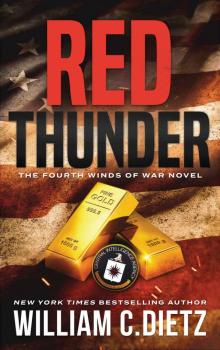 Red Thunder (Winds of War Book 4)
Red Thunder (Winds of War Book 4) Red Tide
Red Tide Graveyard
Graveyard Deadeye
Deadeye Resistance: The Gathering Storm r-1
Resistance: The Gathering Storm r-1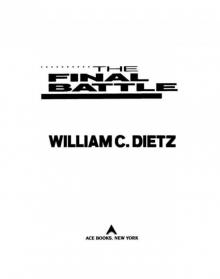 Legion Of The Damned - 02 - The Final Battle
Legion Of The Damned - 02 - The Final Battle Galactic Bounty
Galactic Bounty When All Seems Lost
When All Seems Lost Red Flood (Winds of War Book 2)
Red Flood (Winds of War Book 2) By Blood Alone
By Blood Alone Andromeda's War (Legion of the Damned Book 3)
Andromeda's War (Legion of the Damned Book 3) Hitman: Enemy Within
Hitman: Enemy Within Bodyguard
Bodyguard EarthRise
EarthRise Drifter's War
Drifter's War For More Than Glory
For More Than Glory When Duty Calls
When Duty Calls Into the Guns
Into the Guns Drifter
Drifter Ejecta
Ejecta When All Seems Los lotd-7
When All Seems Los lotd-7 Alien Bounty
Alien Bounty When Duty Calls lotd-8
When Duty Calls lotd-8 Steelheart
Steelheart Matrix Man
Matrix Man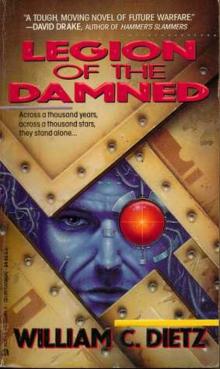 Legion of the Damned
Legion of the Damned Snake Eye
Snake Eye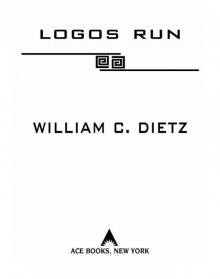 Logos Run
Logos Run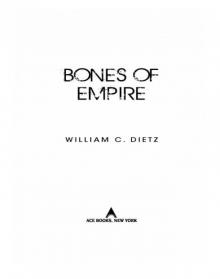 Bones of Empire
Bones of Empire McCade's Bounty
McCade's Bounty Mars Prime
Mars Prime Where the Ships Die
Where the Ships Die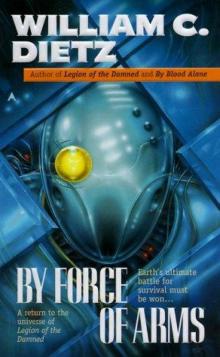 By force of arms lotd-4
By force of arms lotd-4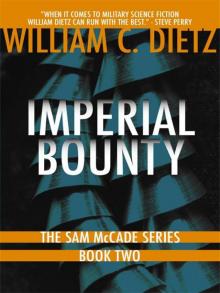 Imperial Bounty
Imperial Bounty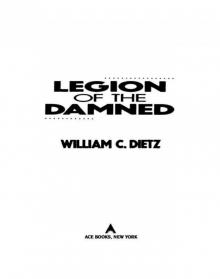 Legion Of The Damned - 01 - Legion of the Damned
Legion Of The Damned - 01 - Legion of the Damned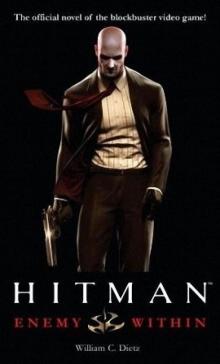 Hitman: Enemy Within h-1
Hitman: Enemy Within h-1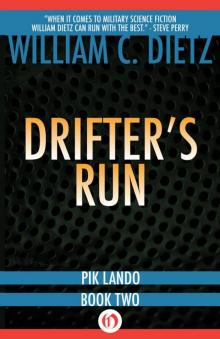 Drifter's Run
Drifter's Run A Fighting Chance
A Fighting Chance McCade on the Run (Sam McCade Omnibus)
McCade on the Run (Sam McCade Omnibus) Legion Of The Damned - 06 - For Those Who Fell
Legion Of The Damned - 06 - For Those Who Fell Halo. Flood
Halo. Flood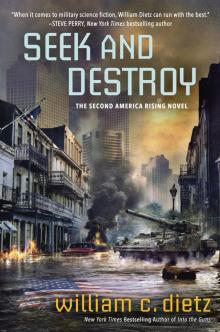 Seek and Destroy
Seek and Destroy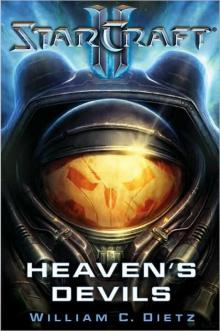 Heaven's Devils si-1
Heaven's Devils si-1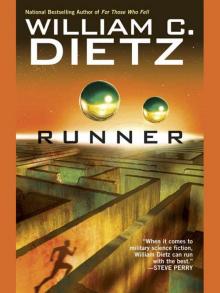 Runner
Runner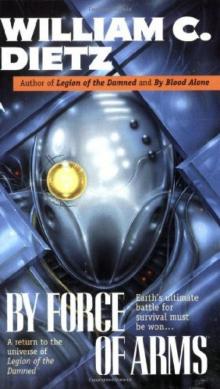 By Force of Arms
By Force of Arms A Hole in the Sky
A Hole in the Sky The Seeds of Man
The Seeds of Man Andromeda's Fall
Andromeda's Fall Andromeda’s Choice
Andromeda’s Choice Prison Planet
Prison Planet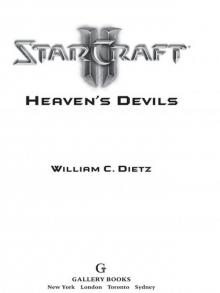 Heaven’s Devils
Heaven’s Devils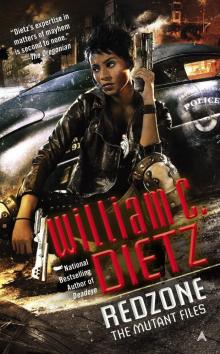 Redzone
Redzone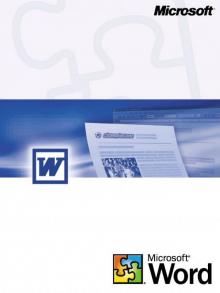 Jedi Knight
Jedi Knight